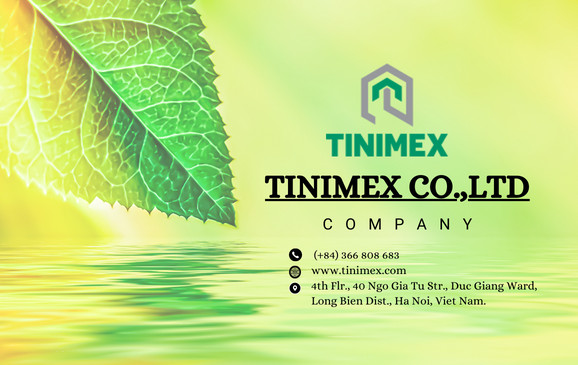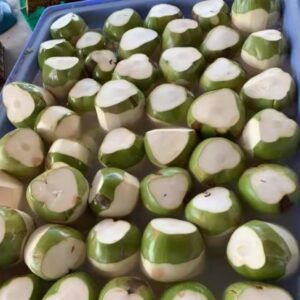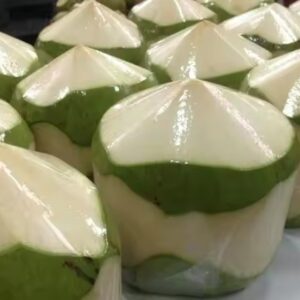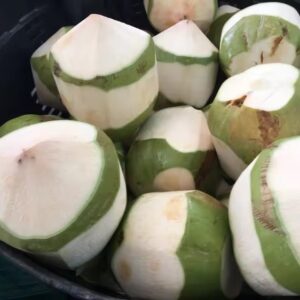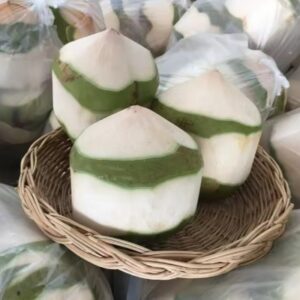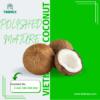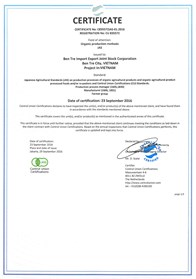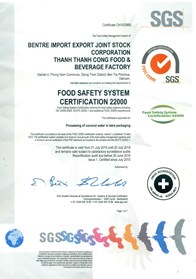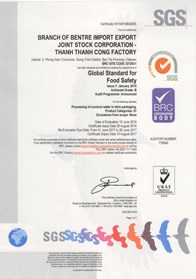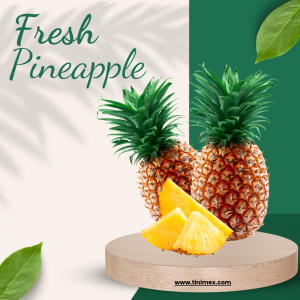PARTIAL GREEN HUSKED COCONUT
Liên hệ
PARTIAL GREEN HUSKED COCONUT
Size: 0.7-1.3kg/nuts
Brix: 7% min
Shelf life: 60 days
Storage: 2-5°C
Packing: 9-16 nuts/carton
Loading: 20’RF; 40’RF
Min order: 1 cont 20’RF
Partial Green Husked Coconut
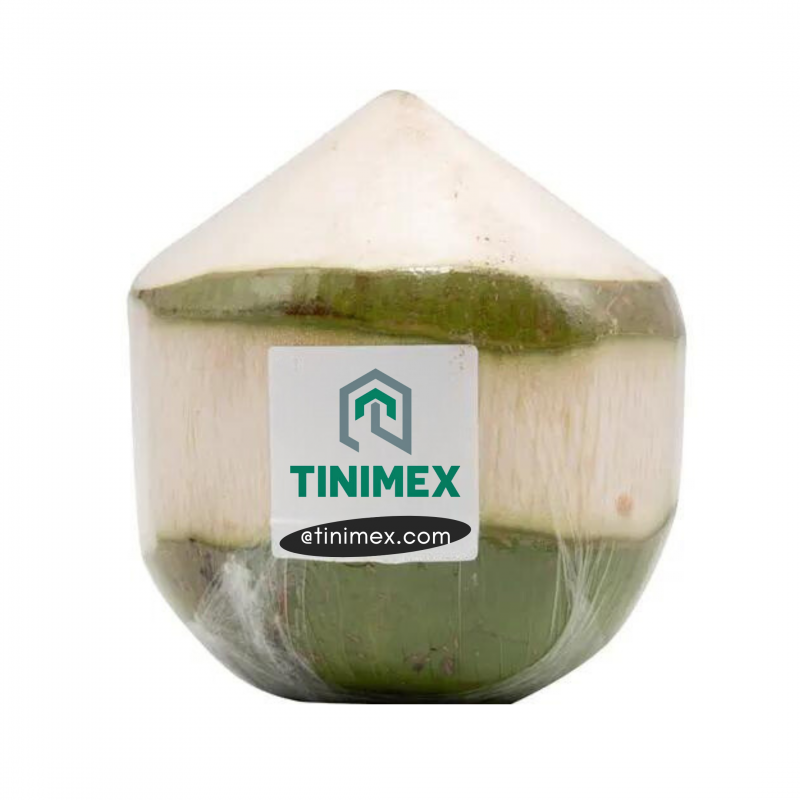
Introduce the characteristics of Partial Green Husked Coconut
Partial green husked coconuts are a variety of coconut characterized by retaining part of their green outer husk while the rest has been removed or trimmed. This state of the coconut can be observed at different stages of its maturity and preparation for consumption or use.
How is Partial Green Husked Coconut different from regular coconut?
While regular coconuts typically have either fully green husks (young coconuts) or brown, fibrous husks (mature coconuts), partial green husked coconuts exhibit a unique intermediate stage. This difference affects their appearance, taste, and applications.
Application of Partial Green Husked Coconut
Consumption of Coconut Water:
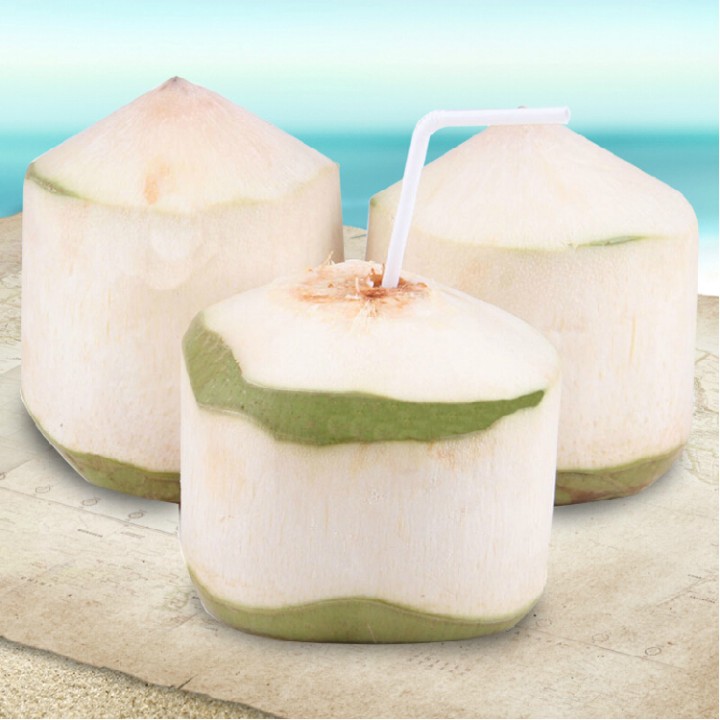
-
- Partial green husked coconuts are valued for their refreshing and hydrating coconut water.
- The water inside these coconuts is often sweeter and more plentiful compared to mature coconuts, yet not as overwhelmingly sweet as in young coconuts.
- Consumers enjoy drinking the coconut water directly from the fruit or using it as a base for smoothies, juices, cocktails, or sports drinks.
- Due to its natural electrolyte content, coconut water is also popular as a post-workout hydration beverage.
Utilization of Coconut Meat in Culinary Dishes:
-
- The meat of partial green husked coconuts can be used in a variety of culinary applications.
- Its texture ranges from semi-firm to slightly tender, making it suitable for both raw and cooked dishes.
- In sweet dishes, the coconut meat can be grated, shredded, or sliced and used in desserts like cakes, pies, puddings, and ice creams.
- In savory dishes, it can be incorporated into salads, stir-fries, curries, soups, and rice dishes to add a tropical flavor and texture.
Potential Use of the Husk for Crafts or as a Natural Packaging Material:
-
- While not as commonly utilized as the water or meat, the husk of partial green husked coconuts has potential applications.
- Craftsmen may use the husk fibers for weaving baskets, mats, ropes, or other traditional handicrafts.
- In eco-friendly packaging solutions, the husk can be processed into biodegradable materials for packaging products, reducing reliance on synthetic materials and promoting sustainability.
- Additionally, in some cultures, coconut husks are used as fuel for cooking or as a natural exfoliant in skincare products.
Overall, partial green husked coconuts offer a range of versatile applications beyond just their water and meat, making them valuable commodities with potential uses in culinary, artisanal, and sustainable packaging industries.
Partial Green Husked Coconut Nutritions
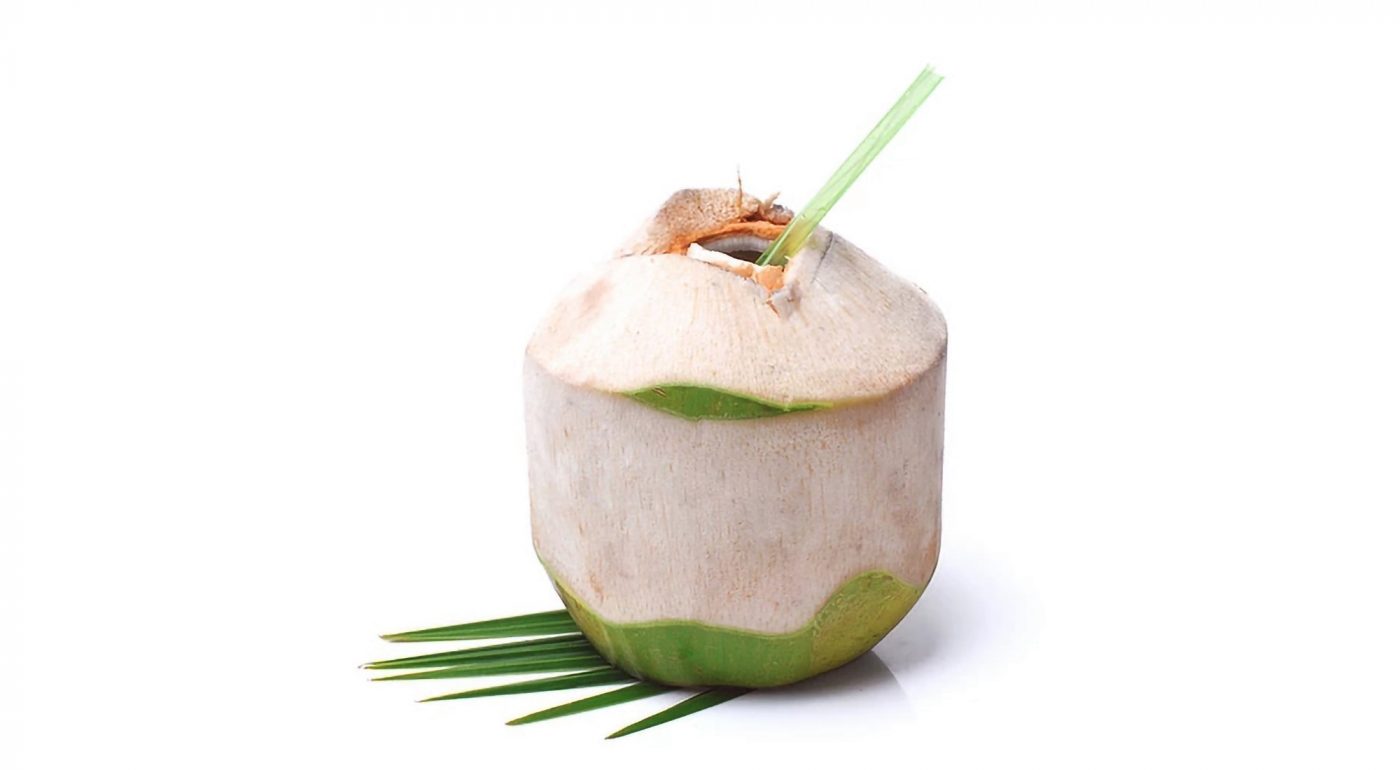
Partial green husked coconuts offer several nutritional benefits, including:
- Hydration from coconut water, which is rich in electrolytes
- Nutrients like vitamins, minerals, and antioxidants found in both the water and meat
- Dietary fiber and healthy fats present in the coconut meat
How to choose high-quality Partial Green Husked Coconut
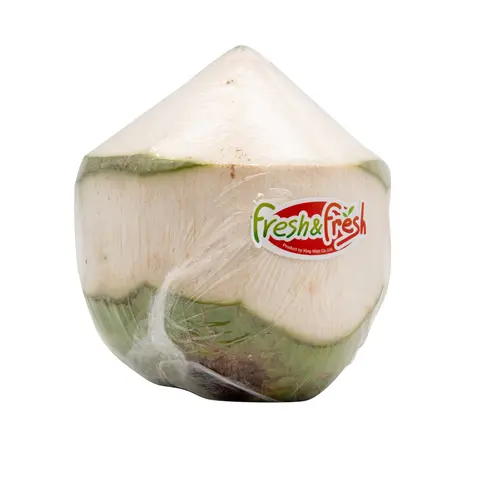
Choosing high-quality partial green husked coconuts requires attention to several key factors to ensure freshness, flavor, and overall quality. Here’s a more detailed explanation of how to select the best ones:
Firmness and Heaviness:
-
- When selecting a partial green husked coconut, gently squeeze it to assess its firmness. A good quality coconut should feel firm and heavy for its size.
- Avoid coconuts that feel soft or mushy, as this may indicate that the coconut is old or has started to spoil.
- Heaviness is an indicator of a higher water content, which means more refreshing coconut water inside.
Husk Condition:
-
- Inspect the husk of the coconut for any signs of damage, such as cracks or mold. A high-quality partial green husked coconut should have a clean, intact husk without any visible blemishes.
- Cracks in the husk can lead to contamination and spoilage, while mold indicates that the coconut is not fresh and may have been stored improperly.
Sound of Coconut Water:
-
- Shake the coconut gently and listen for the sound of sloshing coconut water inside. A high-quality coconut will have a noticeable amount of water, which should produce a distinct sloshing sound.
- However, if the coconut water sounds overly sloshy or too hollow, it may indicate that the coconut is overly mature or has started to ferment.
Appearance of the Husk:
-
- Look for coconuts with a vibrant green husk that still retains some moisture and sheen. Avoid coconuts with dry, brown, or shriveled husks, as they may be older and less fresh.
- The presence of green coloration indicates that the coconut is still in a relatively young and fresh state.
Smell:
-
- Although the husk may limit the ability to smell the coconut directly, if there are any openings or you can detect a slight coconut aroma, it’s a positive sign of freshness.
- Conversely, any unpleasant or sour odors suggest that the coconut may be spoiled or starting to deteriorate.
By considering these factors – firmness, husk condition, sound of coconut water, appearance, and smell – you can confidently select high-quality partial green husked coconuts that are fresh, flavorful, and ideal for consumption or use in various dishes and applications.
Standard for Partial Green Husked Coconut for export
When exporting partial green husked coconuts, adherence to specific standards ensures that the product meets quality requirements and maintains its integrity during transportation and upon arrival at its destination. Here’s a more detailed explanation of the standards for exporting partial green husked coconuts:
Size and Weight Specifications:
-
- Partial green husked coconuts intended for export must meet specific size and weight criteria to ensure consistency and market acceptance.
- The size of the coconut is typically determined by its circumference or diameter, with variations allowed within an acceptable range.
- Weight specifications ensure that the coconuts have a sufficient amount of water and meat, contributing to their overall quality and value.
Husk Color and Condition:
-
- The husk color of partial green husked coconuts should adhere to defined standards, indicating the fruit’s maturity and freshness.
- Coconuts with vibrant green husks that are free from discoloration or blemishes are preferred, as they signify young, healthy fruits.
- Any deviations from the standard color or condition may indicate subpar quality or improper handling, which can affect the coconut’s marketability and shelf life.
Moisture Content and Freshness of Coconut Water and Meat:
-
- Exported partial green husked coconuts must maintain optimal moisture content in both the coconut water and meat to ensure freshness and quality.
- The coconut water should be clear, with a clean, sweet taste, indicating that it is free from contamination or spoilage.
- The meat of the coconut should be tender and succulent, with no signs of dryness or discoloration, indicating its freshness and suitability for consumption or further processing.
Packaging and Handling:
-
- Proper packaging is essential to protect partial green husked coconuts during transit and storage. Packaging materials should be clean, sturdy, and able to provide adequate ventilation to prevent moisture buildup.
- Coconuts should be handled with care to avoid damage to the husk or fruit, which can compromise their quality and marketability.
- Exported coconuts should be labeled accurately with information such as variety, origin, size, weight, and packing date to facilitate traceability and compliance with import regulations.
Adhering to these standards ensures that partial green husked coconuts meet the expectations of international buyers and regulatory authorities, thereby maintaining the reputation of exporters and supporting continued trade in this valuable commodity.
How to preserve Partial Green Husked Coconut
Proper preservation techniques for partial green husked coconuts involve:
- Keeping them in a cool, dry place to prevent mold or spoilage
- Avoiding exposure to direct sunlight or extreme temperatures
- Using refrigeration or sealing methods for extended storage periods
Location: No.40 Ngo Gia Tu Str., Duc Giang Ward, Long Bien Dist, Ha Noi City, Vietnam
Contact: +84 366 808 683
Email: info@tinimex.com
Fanpage: Tinimex
Website: Tinimex.com

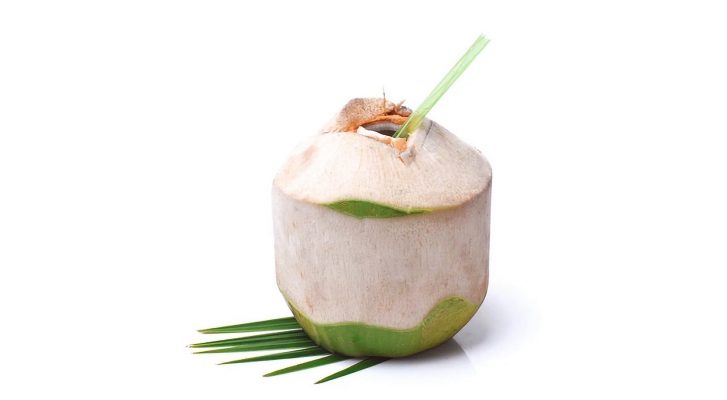


Tinimex was established in 2020 specializing in manufacturing and exporting agricultural products such as:
Spices: Cinnamon, Star Anise, Cardamon, Black pepper, Ginger, Turmeric,…
Fruit with: Fresh fruit: Dragon fruit, Lime, Fresh Coconut,….
Dried fruit: Desiccate Coconut, Dried Mango, Dried Banana, Dried Jackfruit,…
Tinimex’s responsibility, in addition to the main products at the factory, we will also constantly search for new agricultural products from the growing areas or farmers, collect, produce and pack at the factory to meet the needs of customers as well as the market.
We have a head office in Hanoi and two manufacturing plants in Yen Bai Province manufacture Spices and Ben Tre Province manufacture Dried Fruit and Fresh fruit
+ Hanoi Head Office: 4th Flr., 40 Ngo Gia Tu Str., Duc Giang Ward, Long Bien Dist., Ha Noi, Viet Nam.
Our factory:
+ Yen Bai factory: Mau A Town, Văn Yen Dist., Yen Bai Province, Vietnam
+ Ben Tre Factory: Hamlet 2, Son Phu Commune, Giong Trom District, Ben Tre Province
All our Factories strictly control the system by ISO 22000:2018, HACCP, FDA.
Our factory:
+ Yen Bai factory: Mau A Town, Văn Yen Dist., Yen Bai Province, Vietnam
+ Ben Tre Factory: Hamlet 2, Son Phu Commune, Giong Trom District, Ben Tre Province
Hanoi Head Office:
4th Flr., 40 Ngo Gia Tu Str., Duc Giang Ward, Long Bien Dist., Ha Noi, Viet Nam
(+84) 366 808 683
info@tinimex.com
www.tinimex.com
All our Factories strictly control the system by ISO 22000:2018, HACCP, FDA.

Throughout the production process, every stage is tightly controlled, from sourcing raw materials to processing, with absolutely no use of harmful chemicals, preservatives, or artificial colors and flavors. Our focus is on achieving internationally recognized standards. Betrimex's products have obtained various international certifications, including ORGANIC (USDA, EU), BRC, FDA, HALAL, KOSHER, BSCI, FSSC 22000.
Our products are currently available in over 20 countries worldwide.
